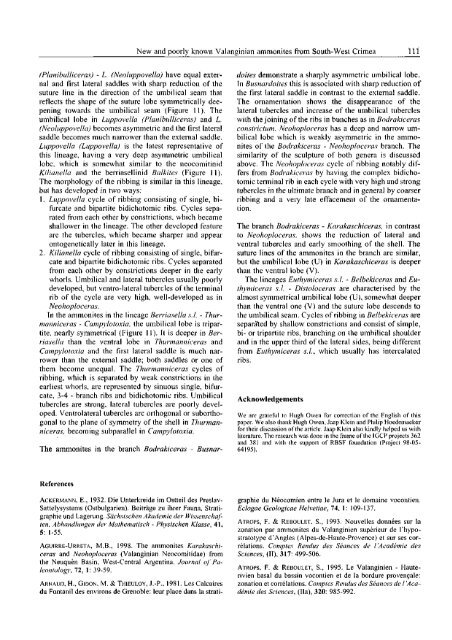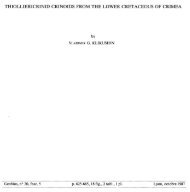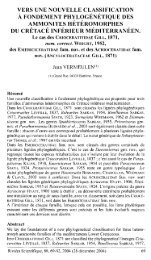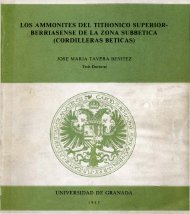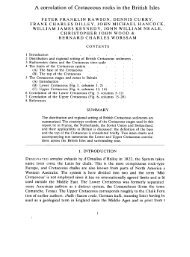New and poorly known Valanginian ammonites from South-West ...
New and poorly known Valanginian ammonites from South-West ...
New and poorly known Valanginian ammonites from South-West ...
You also want an ePaper? Increase the reach of your titles
YUMPU automatically turns print PDFs into web optimized ePapers that Google loves.
<strong>New</strong> <strong>and</strong> <strong>poorly</strong> <strong>known</strong> <strong>Valanginian</strong> <strong>ammonites</strong> <strong>from</strong> <strong>South</strong>-<strong>West</strong> Crimea 111(Planibulliceras) - L. (Neoluppovella) have equal external<strong>and</strong> first lateral saddles with sharp reduction of thesuture line in the direction of the umbilical seam thatreflects the shape of the suture lobe symmetrically deepeningtowards the umbilical seam (Figure 11). Theumbilical lobe in Luppovella (Planibulliceras) <strong>and</strong> L.(Neoluppovella) becomes asymmetric <strong>and</strong> the first lateralsaddle becomes much narrower than the external saddle.Luppovella (Luppovella) is the latest representative ofthis lineage, having a very deep asymmetric umbilicallobe, which is somewhat similar to the neocomitinidKilianella <strong>and</strong> the berriasellinid Balkites (Figure II).The morphology of the ribbing is similar in this lineage,but has developed in two ways:1. Luppovella cycle of ribbing consisting of single, bifurcate<strong>and</strong> bipartite bidichotomic ribs. Cycles separated<strong>from</strong> each other by constrictions, which becameshallower in the lineage. The other developed featureare the tubercles, which became sharper <strong>and</strong> appearontogenetically later in this lineage.2. Kilianella cycle of ribbing consisting of single, bifurcate<strong>and</strong> bipartite bidichotomic ribs. Cycles separated<strong>from</strong> each other by constrictions deeper in the earlywhorls. Umbilical <strong>and</strong> lateral tubercles usually <strong>poorly</strong>developed, but ventro-lateral tubercles of the terminalrib of the cycle are very high, well-developed as inNeolioploceras.Tn the <strong>ammonites</strong> in the lineage Berriasella s.l. - Thurmanniceras- Campylotoxia. the umbilical lobe is tripartite,nearly symmetrical (Figure II). It is deeper in Berriasellathan the ventral lobe in Thurmanniceras <strong>and</strong>Campylotoxia <strong>and</strong> the first lateral saddle is much narrowerthan the external saddle; both saddles or one ofthem become unequal. The Thurmanniceras cycles ofribbing, which is separated by weak constrictions in theearliest whorls, are represented by sinuous single, bifurcate,3-4 - branch ribs <strong>and</strong> bidichotomic ribs. Umbilicaltubercles are strong, lateral tubercles are <strong>poorly</strong> developed.Ventrolateral tubercles arc orthogonal or suborthogonalto the plane of symmetry of the shell in Thurmanniceras,becoming subparallel in Campylotoxia.The <strong>ammonites</strong> in the branch Bodrakiceras- Busnardoitesdemonstrate a sharply asymmetric umbilical lobe.In Busnardoites this is associated with sharp reduction ofthe first lateral saddle in contrast to the external saddle.The ornamentation shows the disappearance of thelateral tubercles <strong>and</strong> increase of the umbilical tubercleswith the joining of the ribs in bunches as in Bodrakicerasconstrictum. Neolioploceras has a deep <strong>and</strong> narrow umbilicallobe which is weakly asymmetric in the <strong>ammonites</strong>of the Bodrakiceras - Neohoploccras branch. Thesimilarity of the sculpture of both genera is discussedabove. The Neohoploccras cycle of ribbing notably differs<strong>from</strong> Bodrakiceras by having the complex bidichotomicterminal rib in each cycle with very high <strong>and</strong> strongtubercles in the ultimate branch <strong>and</strong> in general by coarserribbing <strong>and</strong> a very late effacemenl of the ornamentation.The branch Bodrakiceras - Karakaschiceras, in contrastto Neohoploccras. shows the reduction of lateral <strong>and</strong>ventral tubercles <strong>and</strong> early smoolhing of the shell. Thesuture lines of the <strong>ammonites</strong> in the branch are similar,but the umbilical lobe (U) in Karakaschiceras is deeperthan the ventral lobe (V).The lineages Euthymiceras s.l. - Belbekiceras <strong>and</strong> Euthymicerass.l. - Distoloceras are characterised by thealmost symmetrical umbilical lobe (U), somewhat deeperthan the ventral one (V) <strong>and</strong> the suture lobe descends tothe umbilical seam. Cycles of ribbing in Belbekiceras areseparated by shallow constrictions <strong>and</strong> consist of simple,bi- or tripartite ribs, branching on the umbilical shoulder<strong>and</strong> in the upper third of the lateral sides, being different<strong>from</strong> Euthymiceras s.L. which usually has intercalatedribs.AcknowledgementsWe arc grateful lo Hugh Owen for correction of the English of thispaper. We also (hank Hugh Owen, Jaap Klein <strong>and</strong> Philip Hoedemaekertor their discussion of the article. Jaap Klein also kindly helped us withliterature. The research was done in the frame of the IGCP projects 362<strong>and</strong> 381 <strong>and</strong> with the support of RBSF foundation (Project 98-05-64195).ReferencesAcktermann. E., 1932. Die Unterkreide im Ostteil des Preslav-Sattelysystems (Ostbulgarien). Beitrage zu ihrer Fauna, Stratigraphieund Lagerung. Siichsischen Akademie der Wissenschaften.Abh<strong>and</strong>hwgen der Mathematisch - Phvsischen Klasse, 41,S: 1-55.AGUtRRE-URRETA, MB., 1998. The <strong>ammonites</strong> Karakaschiceras<strong>and</strong> Neohoptoceras (<strong>Valanginian</strong> Neocomitidae) <strong>from</strong>the Neuquen Basin. <strong>West</strong>-Central Argentina. Journal of Paleontology.72, 1: 39-59.ArnAim, H„ Gidon, M. & THIEULOY, J.-P., 1981. LesCalcairesdu Fontanil des environs de Grenoble: leur place dans la stratigraphiedu Neocomten entre le Jura et le domaine vocontien.Eclogue Geologicae Helvetiae, 74. 1: 109-137.ATROPS, F. & REBOULET. S., 1993. Nouvelles donnees sur lazonation par <strong>ammonites</strong> du Valanginien superieur de 1'hypostratotyped'Angles (Alpes-de-Haute-Provence) et sur ses correlations.Comptes Rendus des Seances de I'Academie desSciences, (II), 317: 499-506.ATROPS. F. & REBOULET, S., 1995. Le Valanginien - Hauterivienbasal du bassin vocontien et de la bordure provencale:zonation et correlations. Comptes Rendus des Seances de I Academicdes Sciences, (Ila), 320: 985-992.


